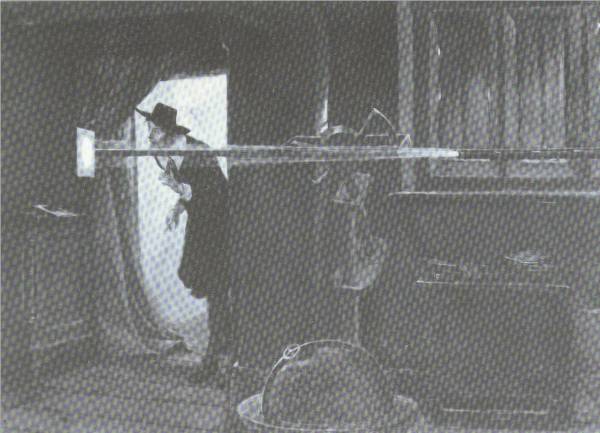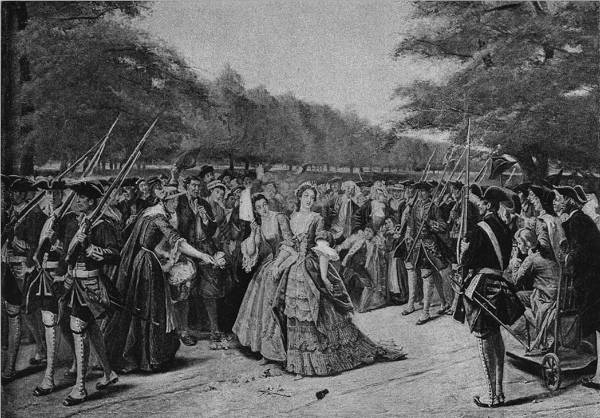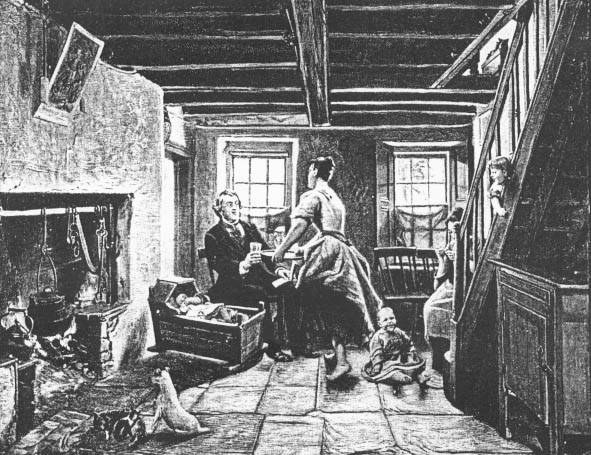

The quotations at the head of each section are taken from Graves' list of Royal Academy exhibitors, and represent the inspiration for the painting, as submitted to the Academy's catalogue by Eyre Crowe.

Title: A Rifle Match - at Dunnottar, N.B. (1890)
Medium: oil
Exhibited: Royal Academy, 1890

Reproduced in Royal Academy Pictures, 1890, p. 61
Illustrated London News, 31 May 1890:
Mr Eyre Crowe's 'Rifle Match' (794) introduces to our notice a Volunteer of at least nine feet in length, in the act of discharging his rifle in a direction which suggests a very strange trajectory.
The Times, 20 June 1890:
Further to the right, above a very poor performance by Mr. Eyre Crowe ...

Title: Writing a Message to St Helena (1891)
Medium: oil
Size: 23½ x 18 inches
Exhibited: Royal Academy, 1891
'Marie Louise, holding the hand of her son, the Roi de Rome, guides the pen in writing a letter to Napoleon at St. Helena, and sends along with it a lock of the child's hair'
Reproduced in Royal Academy Pictures, 1891, p. 86
Athenaeum, 23 May 1891:
Mr. Eyre Crowe's efforts will reinstate him in public favour. He sends three pictures ... the smallest is most highly finished. It is called Writing a Message to St Helena (388), an incident in the history of the Empress Marie Louise, who taught the little King of Rome to write letters to his imprisoned father. She sits at a writing table with the pretty, fair-haired child in her lap, and carefully guides his hand over the paper. The boy's earnest expression and the empress's attentive air are good points in a cabinet example more than usually finished. The scene is a library; there are pictures on the walls, and a laureated bust of Napoleon on a pedestal.
------------------
This painting was one of those remaining in Eyre Crowe's possession at his death, and was sold at Christie's in London, at an auction of his remaining work on 18 March 1911, for £15 15s.

Title: The Founder of English Astronomy (1891)
Medium: oil
Size: 76.2 x100.3 cm
Exhibited: Royal Academy, 1891; Liverpool autumn exhibition, 1891
Current owner: Walker Art Gallery, Liverpool (WAG 1805)
'Jeremiah Horrocks, curate at Hoole, Lancashire, having attended first to his religious duties on Sunday, November 24, 1639, and after having previously prepared his instrument for the observation of the transit of Venus, returns just in time to witness the event which he alone had correctly predicted as going to take place'

Walker Art Gallery, Liverpool
Athenaeum, 23 May 1891:
The small room is a true portrait of that still existing in Carr House, Hoole, and the rude transit instrument of the period is placed near the green curtain of the window, its uncouth and clumsy supports being conspicuous in the half gloom, and the sheet of paper is duly suspended to receive the luminous image, while athwart the scene pours that narrow ray of light which comprised the dark figure of Venus. The predicted hour fell on a Sunday, when Horrocks was bound to intermit his observations to do duty at the neighbouring church. As it happened, he was able to return home in the nick of time. Mr. Crowe has shown Horrocks entering the room. The action of the observer, the eager eyes and parted lips, his hand lifted in wonder, and his delighted expression, are capitally and sympathetically given.
-----------------------
According to his diary, Crowe began work on this painting, then called 'Horrocks seeing the actual transit of Venus', in October 1889. He used a telescope set up by his friend from the Reform Club, the astronomer Sir Norman Lockyer, director of the Solar Physics Observatory at South Kensington. The painting depicts the Puritan clergyman Jeremiah Horrocks (1617-1641) observing Venus passing in front of the sun, using a projection onto a screen. Crowe is said to have visited Horrocks' rented lodgings at Hoole in order to sketch the scene, and to have followed the description of the experiment given in a book by A.B. Whatton in an attempt to make the picture as authentic as possible. Despite these efforts, it is now known that the clothes and the instruments are both inaccurate.
The painting was donated to the Walker Art Gallery in Liverpool by Charles William Jones in the same year as its exhibition at the Royal Academy, and formed part of the Liverpool Autumn Exhibition of 1891. It is now hanging in the Liverpool Museum as part of its Astronomy exhibition.
The painting is catalogued and reproduced in the volume Victorian and Edwardian Paintings in the National Museums and Galleries on Merseyside, Vol. 2 - 'Victorian and Edwardian Paintings in the Walker Art Gallery and at Sudley House, by Edward Morris (Her Majesty's Stationary Office, 1996)

Title: Sir Joseph Archer Crowe K.C.M.G. (1891)
Medium: oil
Exhibited: Royal Academy, 1891
This portrait of Crowe's brother was not reviewed by any of the principal newspapers or periodicals.

Title: Lady Coventry's Escort (1892)
Medium: oil
Size: 50 x 74 inches
Exhibited: Royal Academy, 1892; University of Minnesota, 1977 (sketches)
'Lady Coventry, having been insulted in the park Sunday se'night, the King (George II) heard of it and said that to prevent the same for the future, she should have a guard, etc.'

Reproduced in Royal Academy Pictures, 1892, p. 61
The Scotsman, 7 May 1892:
Mr Eyre Crowe, the Associate... is responsible for a very bad picture, painted on a large scale, which he calls 'Lady Coventry's Escort' (535). That is should have been hung on the line is not creditable to the Hanging Committee.
The Times, 21 May 1892:
Mr Eyre Crowe [has] a picture (535) which the French would expressively describe as inqualifiable. By what fatality is is that certain painters, whose hand and eye are not what they were, still attack the most complicated and difficult subjects? A simple portrait, a simple landscape, from their brush might pass without offence; but they attempt a crowd, an elaborate piece of history, a picture with much action and movement in it, and they leave the critic and the public no option.
-----------
The quotation accompanying the picture came from Horace Walpole's Letters, and referred to the vain action of the celebrated beauty Lady Maria Coventry (1733-1760) in taking up King George II's offer of an escort of two servants of the guard and 12 soldiers to accompany her on a walk through Hyde Park, after she had been mobbed the previous week by people eager to see her face.
Three sketches for the picture were sold at auction in 1972 and 1973, and were exhibited at the University of Minnesota in 1974 as part of the exhibition 'The Art of Mind of Victorian England: Paintings from the Forbes Magazine Collection'. The painting itself was part of the collection of Columbia College (now Loras College), Dubuque, Iowa, until 1977, and is now in a private collection.

Title: Peg of Limavaddy (1893)
Medium: oil
Size: 24 x 36 inches
Exhibited: Royal Academy, 1893
'Presently a maid enters with the liquor, etc.'

Reproduced in Thackeray's Haunts and Homes by Eyre Crowe A.R.A. (Smith, Elder and Co., 1897)
Athenaeum, 29 April 1893:
[Comparing George A. Storey and Eyre Crowe:] Although they both deal in humerous and pathetic genre, these painters work in moods and methods, to say nothing of their respective manners, which are very distinctly defined, the one [Storey] inclining to follow De Hoogue, the other to Hogarth - painters who are less far apart than might be supposed. Mr. Storey's sense of grace and his affection for light, shade and tone save him from the worst faults of Mr. Crowe, who is, however, a sterling humourist of the more masculine strain, and the nearest of the moderns to Hogarth ... Mr. Crowe's 'Nelson at Portsmouth' [correctly, 'Nelson leaving England for the last time' (1888)] showed that he has not always a keen sense of the ridiculous, yet his 'Brothers of the Brush' [1873] and 'Dr Johnson in Fleet Street' [unidentified; possibly 'A Scene at the Mitre' (1857)] are happy specimens of humour ... Mr. Crowe's single contribution, Peg of Limavaddy (802), owes its subject to the narrative of Thackeray's visit to Limavaddy, that lively Irish town, whose comely 'Peg', the buxom maid of the inn, he immortalised. Mr. Crowe went to Limavaddy, and, discovering the inn where the author of 'Vanity Fair' put up, painted the room where the satirist caught sight of his heroine, its walls formerly whitewashed, its oaken tables, its rude settles, rough staircase, and windows screened in green. We have them here to the life, warm in lighting, well drawn, and solidly, if rather heavily painted, and, altogether, good and sound in art. Thackeray, an excellent likeness, if not looking rather too old for the event in question, sits at the table, to which the strapping handmaiden approaches with the beer he has asked for. Both the figures are capitally designed and painted, that of the damsel being robust, lithe despite her stays and too abundent skirts, and, in its way, graceful as well as animated - above all, simple and true to nature. The other figures in the room are good.
Illustrated London News, 27 May 1893:
Mr. Eyre Crowe, profiting by his friendship with the late W.M. Thackeray, introduces an excellent portrait of that writer into his picture of 'Peg of Limavaddy' (802), who played a subordinate part in Thackeray's Irish journey.
--------------------
In Thackeray's Haunts and Homes, Eyre Crowe recalled that William Makepeace Thackeray had gone to Ireland in 1842. Crowe himself visited Ireland some years later and searched out the house immortalised by Thackeray in his Irish Sketch Book. 'Here is the cheery interior, with the simmering pot of murphies and the indwellers, as the wonderful verses described - drawn by him who pens these lines, who must record his delight at the discovery of this country tap-room quite unchanged' (Thackeray's Haunts and Homes, p. 38).


Copyright (c) 2005 Kathryn J. Summerwill. All rights reserved.






